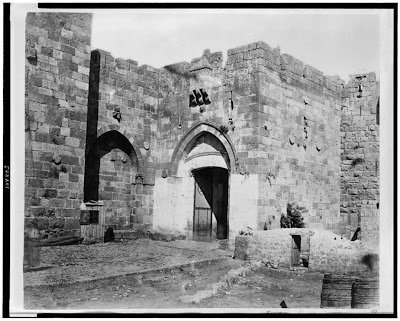Showing posts with label Israel's Picture a day. Show all posts
Showing posts with label Israel's Picture a day. Show all posts
Friday, April 11, 2014
Tuesday, November 26, 2013
Israel's History - a Picture a Day (Beta) - Walls & Gates of Jerusalem
Israel's History - a Picture a Day (Beta) |
The Chatham University Archives placed all 110 colored slides from the"Holy Land Lantern Slides"online, and in this posting we present a selection to focus on the collection's pictures of Jerusalem's walls and gates.
This Picture of Jaffa Gate has been featured in previous postings when we found it in other collections.
We also determined that the photo was taken prior to 1898 because of a glimpse of the moat wall on the right side of the picture. The wall was torn down and the moat filled in so that the Germany emperor's carriage could enter.
There are no pictures of the Zion, Dung and Herod Gates of the Old City. The "New Gate" of the Old City, an entrance built for access into the Christian Quarter, was constructed in 1889, after the photographs were taken.
The "lions" carved on both sides of the gate are actually panthers, the symbol of the Mamluk Sultan Baybars (1223-1277). The panthers were believed to have been part of a Mamluki structure and placed at the gate by Suleiman to commemorate the Ottoman victory over the Mamluks in 1517. View an earlier posting on Lions Gate here.
See our previous feature on
Sha'ar Harachamim and the graves
beneath it here.
|
Monday, October 21, 2013
Walls and Gates of Jerusalem - Part 4
Israel's History - a Picture a Day (Beta) |
|
When was this picture of the Jaffa Gate taken? Here are clues.
William Seward (Abraham Lincoln's secretary of state) wrote in 1871 that the population of the Old City was 16,000, comprised of 8,000 Jews, 4,000 Mohammedans, and 4,000 Christians.
Two major architectural changes in the Jaffa Gate in 1898 and 1908 help historians date the early photographs of the Jaffa Gate in Jerusalem. The first was the breaching of the wall in 1898 to permit German Emperor Wilhelm II to ride into the Old City without dismounting and with his escort of carriages. To built the roadway, a moat -- visible in pre-1898 photos -- had to be filled in. Click on photos to enlarge. Click on captions to view the original pictures. In 1908 the Turkish authorities built a clock tower near the gate in honor of Sultan Abdul Hamid II.
The British captured Jerusalem in 1917, and the tower was knocked down in 1922. We can now determine that the Emory University collection photo was taken after 1908 when the tower was erected. Once the Jaffa Gate walls were breached, the entrance became a major thoroughfare, especially as an entrance to the Turkish army base and prison in the Old City, known as the "Kishle." The shops outside the gate were torn down prior to the German Emperor's visit.
An photo enlargement of the Jaffa Gate and the shops (from the picture taken before 1898) shows a Jewish millinery shop with a Hebrew sign selling various headgear for religious Jews, some of whom are standing outside of the shop.
The Library of Congress caption notes: Photograph taken before October 1898 visit of Kaiser Wilhelm II to Jerusalem when a breach was made in the wall near the Jaffa Gate. (Source: L. Ben-David, Israel's History - A picture a day, Oct. 30, 2012.) |
Subscribe to:
Posts (Atom)











